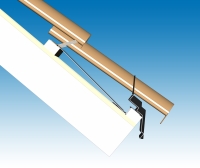Roof Homes For Sparrows
The common sparrow in the Dutch towns of Noordwijk, Amsterdam, Alkmaar and Hardenberg will soon have more places to call home. A test project on home roofs in these communities will provide housing specially designed for the sparrows, so that they are sure to have nesting area available.
In 2005 the wild sparrow took several blows in the Netherlands. Openings in homes and roofs were better sealed. The amount of shrubs in parks, sidewalks and other public places was reduced for security reasons. Sparrows prefer to make their nests in openings in buildings, or in the tight branches of shrubs and bushes.
 In order to give the sparrow abundant nesting areas in neighborhoods, the roofing firm Comfortdak has designed a special roof tile, the Vogelvide (see photo), which allows sparrows to nest near the foot of the roof. The first unit was placed on a rental house in on the Abraham Rademakerstraat in Noordwijk during a presentation by the bird protection group Vogelbescherming Nederland on Tuesday. In total approximately 100 homes will be fitted with the special tiles.
In order to give the sparrow abundant nesting areas in neighborhoods, the roofing firm Comfortdak has designed a special roof tile, the Vogelvide (see photo), which allows sparrows to nest near the foot of the roof. The first unit was placed on a rental house in on the Abraham Rademakerstraat in Noordwijk during a presentation by the bird protection group Vogelbescherming Nederland on Tuesday. In total approximately 100 homes will be fitted with the special tiles.
Sources:
Huisje voor huismus
Vogelvide – redding voor huismus?
Photo from Vogelbescherming Nederland website



